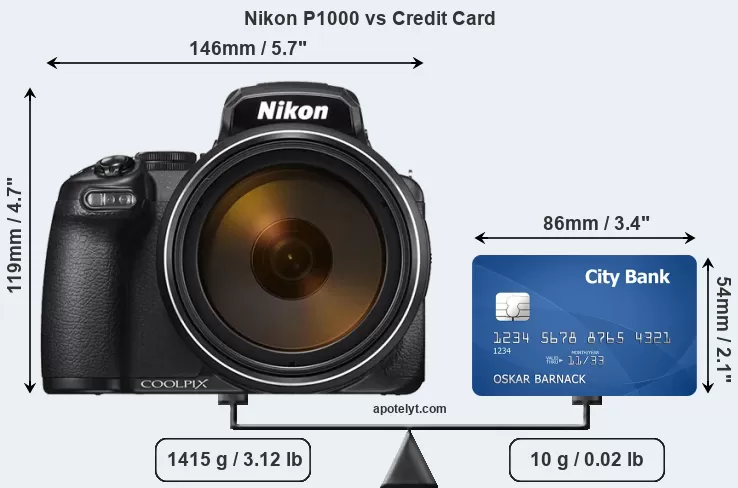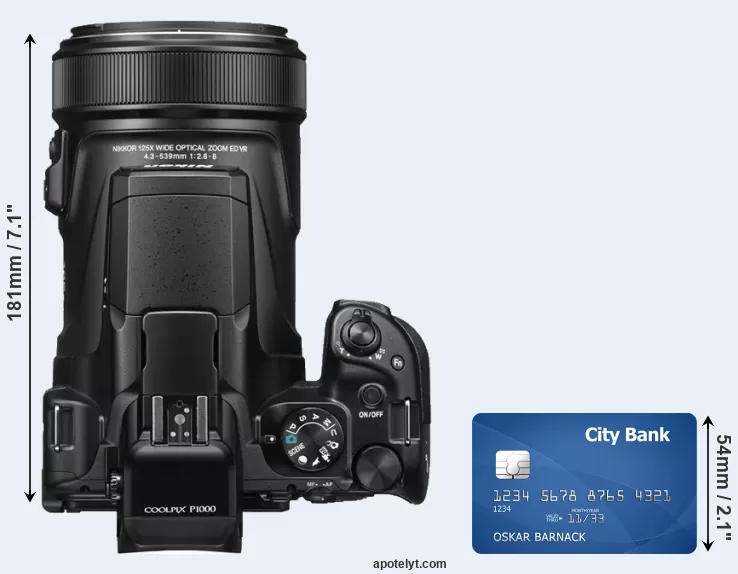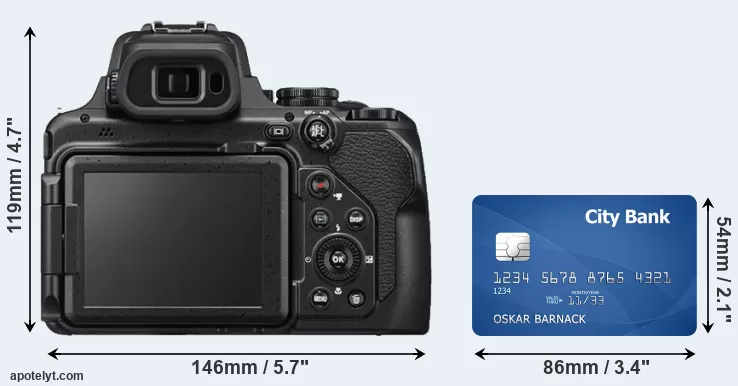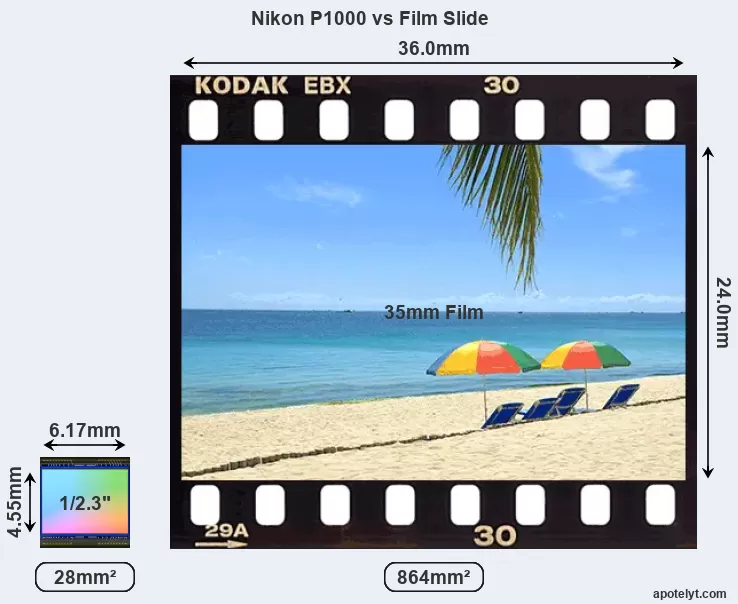Nikon P1000 Comparison Review
The Nikon Coolpix P1000 is a fixed lens compact camera that was officially introduced in July 2018 and is equipped with a 1/2.3-inch sensor. It offers a resolution of 15.9 megapixel.

Is the Nikon P1000 a good camera? The P1000 has a Camera Elo of 2248. This rating puts the P1000 among the top 20 percent of all superzoom compact cameras. In terms of its sensor size category (small sensor cameras), the P1000 ranks among the top 10 percent. Based on its within category standings, the camera earns a 5-star performance rating.
| Nikon P1000 |
|---|
| Fixed lens compact camera |
| 24-3000mm f/2.8-8.0 |
| 15.9 MP, 1/2.3" Sensor |
| 4K/30p Video |
| ISO 100 - 6 400 |
| Electronic viewfinder (2359k dots) |
| 3.2 LCD, 921k dots |
| Swivel screen (not touch-sensitive) |
| 7 shutter flaps per second |
| 250 shots per battery charge |
| 146 x 119 x 181 mm, 1 415 g |
Read on to find out more about the camera's size, sensor, features, reception by expert reviewers, and how it compares to other digital cameras.
Body comparison with a credit card
The side-by-side display below illustrates the physical size of the Nikon P1000 vis-à-vis a credit card. Three consecutive perspectives from the front, the top, and the back are presented. All width, height and depth measures are rounded to the nearest millimeter.



The table below summarizes the key physical specs of the Nikon P1000 alongside a set of similar cameras. If you want to review a particular camera pair side-by-side, just move across to the CAM-parator tool and choose from the broad selection of possible comparisons there.

| Camera Model |
Camera Width |
Camera Height |
Camera Depth |
Camera Weight |
Battery Life |
Weather Sealing |
Camera Launch |
Launch Price (USD) |
Street Price |
||
|---|---|---|---|---|---|---|---|---|---|---|---|
| 1. | Nikon P1000 | 146 mm | 119 mm | 181 mm | 1415 g | 250 | n | Jul 2018 | 999 | amazon.com | |
| 2. | Leica D-LUX 7 | 115 mm | 66 mm | 65 mm | 392 g | 300 | n | Nov 2018 | 1,195 | ebay.com | |
| 3. | Leica V-LUX 2 | 124 mm | 80 mm | 95 mm | 520 g | 410 | n | Sep 2010 | 849 | ebay.com | |
| 4. | Nikon Coolpix A | 111 mm | 64 mm | 40 mm | 299 g | 230 | n | Mar 2013 | 1,099 | ebay.com | |
| 5. | Nikon A1000 | 114 mm | 72 mm | 41 mm | 330 g | 250 | n | Jan 2019 | 429 | ebay.com | |
| 6. | Nikon B600 | 122 mm | 82 mm | 99 mm | 500 g | 280 | n | Jan 2019 | 349 | ebay.com | |
| 7. | Nikon P900 | 140 mm | 103 mm | 137 mm | 899 g | 360 | n | Mar 2015 | 599 | ebay.com | |
| 8. | Panasonic LX100 II | 115 mm | 66 mm | 65 mm | 392 g | 300 | n | Aug 2018 | 999 | ebay.com | |
| 9. | Sony HX95 | 102 mm | 58 mm | 36 mm | 242 g | 370 | n | Aug 2018 | 429 | ebay.com | |
| 10. | Sony HX99 | 102 mm | 58 mm | 36 mm | 242 g | 370 | n | Aug 2018 | 449 | ebay.com | |
| 11. | Sony WX800 | 102 mm | 58 mm | 36 mm | 233 g | 370 | n | Oct 2018 | 399 | ebay.com | |
| Note: Measurements and pricing do not include easily detachable parts, such as add-on or interchangeable lenses or optional viewfinders. | |||||||||||
The listed prices provide an indication of the market segment that the manufacturer of the cameras have been targeting. The Nikon P1000 was launched in the US market at a price of $999. Usually, retail prices stay at first close to the launch price, but after several months, discounts become available. Later in the product cycle and, in particular, when the replacement model is about to appear, further discounting and stock clearance sales often push the camera price considerably down. Then, after the new model is out, very good deals can frequently be found on the pre-owned market.

Check P1000 price at
amazon.com
Sensor comparison with a 35mm slide
The imaging sensor is at the core of digital cameras and its size is one of the main determining factors of image quality. A large sensor will generally have larger individual pixels that offer better low-light sensitivity, provide wider dynamic range, and have richer color-depth than smaller pixels in a sensor of the same technological generation. Moreover, a large sensor camera will give the photographer more control over depth-of-field in the image and, thus, the ability to better isolate a subject from the background. On the downside, larger sensors tend to be associated with larger, more expensive camera bodies and lenses.
The Nikon P1000 features a 1/2.3-inch sensor and has a format factor (sometimes also referred to as "crop factor") of 5.6. Within the spectrum of camera sensors, this places the Nikon P1000 among the smaller-sensor digicams that favor affordability and compact design.

For most cameras, data on sensor performance has been reported by DXO Mark. This service determines an overall sensor rating, as well as sub-scores for low-light sensitivity ("DXO Sports"), dynamic range ("DXO Landscape"), and color depth ("DXO Portrait"). The following table provides an overview of the physical sensor characteristics, as well as the sensor quality measurements for a selection of alternatives.

| Camera Model |
Sensor Class |
Resolution (MP) |
Horiz. Pixels |
Vert. Pixels |
Video Format |
DXO Portrait |
DXO Landscape |
DXO Sports |
DXO Overall |
||
|---|---|---|---|---|---|---|---|---|---|---|---|
| 1. | Nikon P1000 | 1/2.3 | 15.9 | 4608 | 3456 | 4K/30p | 20.6 | 12.1 | 1044 | 51 | |
| 2. | Leica D-LUX 7 | Four Thirds | 16.8 | 4736 | 3552 | 4K/30p | 22.9 | 12.8 | 1002 | 72 | |
| 3. | Leica V-LUX 2 | 1/2.3 | 14.0 | 4320 | 3240 | 1080/60i | 19.4 | 10.7 | 321 | 39 | |
| 4. | Nikon Coolpix A | APS-C | 16.1 | 4928 | 3264 | 1080/30p | 23.4 | 13.8 | 1164 | 80 | |
| 5. | Nikon A1000 | 1/2.3 | 15.9 | 4608 | 3456 | 4K/30p | 20.7 | 12.2 | 1095 | 52 | |
| 6. | Nikon B600 | 1/2.3 | 15.9 | 4608 | 3456 | 1080/30p | 20.7 | 12.2 | 1095 | 52 | |
| 7. | Nikon P900 | 1/2.3 | 15.9 | 4608 | 3456 | 1080/60p | 20.2 | 11.6 | 727 | 47 | |
| 8. | Panasonic LX100 II | Four Thirds | 16.8 | 4736 | 3552 | 4K/30p | 22.8 | 12.7 | 979 | 72 | |
| 9. | Sony HX95 | 1/2.3 | 18.0 | 4896 | 3672 | 4K/30p | 20.6 | 12.1 | 1057 | 51 | |
| 10. | Sony HX99 | 1/2.3 | 18.0 | 4896 | 3672 | 4K/30p | 20.6 | 12.1 | 1058 | 51 | |
| 11. | Sony WX800 | 1/2.3 | 18.0 | 4896 | 3672 | 4K/30p | 20.6 | 12.2 | 1070 | 51 | |
| Note: DXO values in italics represent estimates based on sensor size and age. | |||||||||||
Many modern cameras are not only capable of taking still images, but also of capturing video footage. The P1000 indeed provides movie recording capabilities. The highest resolution format that the P1000 can use is 4K/30p.
Feature comparison
Beyond body and sensor, cameras can and do differ across a range of features. The tables below summarize some of the other core capabilities of the Nikon P1000 in connection with corresponding information for a sample of similar cameras.

| Camera Model |
Viewfinder (Type or 000 dots) |
Control Panel (yes/no) |
LCD Specifications (inch/000 dots) |
LCD Attach- ment |
Touch Screen (yes/no) |
Max Shutter Speed * |
Max Shutter Flaps * |
Built-in Flash (yes/no) |
Built-in Image Stab |
||
|---|---|---|---|---|---|---|---|---|---|---|---|
| 1. | Nikon P1000 | 2359 | n | 3.2 / 921 | swivel | n | 1/4000s | 7.0/s | Y | Y | |
| 2. | Leica D-LUX 7 | 2764 | n | 3.0 / 1240 | fixed | Y | 1/4000s | 11.0/s | n | Y | |
| 3. | Leica V-LUX 2 | 202 | n | 3.0 / 460 | swivel | n | 1/2000s | 11.0/s | Y | Y | |
| 4. | Nikon Coolpix A | optional | n | 3.0 / 921 | fixed | n | 1/2000s | 4.0/s | Y | n | |
| 5. | Nikon A1000 | 1166 | n | 3.0 / 1036 | tilting | Y | 1/4000s | 7.0/s | Y | Y | |
| 6. | Nikon B600 | none | n | 3.0 / 921 | fixed | n | 1/4000s | 7.4/s | Y | Y | |
| 7. | Nikon P900 | 921 | n | 3.0 / 921 | swivel | n | 1/4000s | 7.0/s | Y | Y | |
| 8. | Panasonic LX100 II | 2764 | n | 3.0 / 1240 | fixed | Y | 1/4000s | 11.0/s | n | Y | |
| 9. | Sony HX95 | 638 | n | 3.0 / 922 | tilting | n | 1/2000s | 10.0/s | Y | Y | |
| 10. | Sony HX99 | 638 | n | 3.0 / 922 | tilting | Y | 1/2000s | 10.0/s | Y | Y | |
| 11. | Sony WX800 | none | n | 3.0 / 922 | tilting | Y | 1/2000s | 10.0/s | Y | Y | |
| Note: *) Information refers to the mechanical shutter, unless the camera only has an electronic one. | |||||||||||
The LCD screen on the Nikon Coolpix P1000 is flexibly attached to the body. In particular, the LCD is hinged on the side and can be flipped out for odd-angle shots in both portrait and landscape orientation. Also, this fully articulated, swivel type of LCD attachment is often appreciated by videographers for its flexibility. Moreover, v-loggers like the design because the screen can be turned to be front-facing.

One convenient feature of the P1000 is the presence of an on-board flash. While this built-in flash is not very powerful, it can at times be useful as a fill-in light to brighten deep shadow areas.
Connection comparison
For some imaging applications, the extent to which a camera can communicate with its environment can be an important aspect in the camera decision process. The table below provides an overview of the connectivity of the Nikon Coolpix P1000 and, in particular, the interfaces the cameras (and selected comparators) provide for accessory control and data transfer.

| Camera Model |
Hotshoe Port |
Internal Mic / Speaker |
Microphone Port |
Headphone Port |
HDMI Port |
USB Port |
WiFi Support |
NFC Support |
Bluetooth Support |
||
|---|---|---|---|---|---|---|---|---|---|---|---|
| 1. | Nikon P1000 | Y | stereo / mono | Y | - | micro | 2.0 | Y | - | Y | |
| 2. | Leica D-LUX 7 | Y | stereo / mono | - | - | micro | 2.0 | Y | - | Y | |
| 3. | Leica V-LUX 2 | Y | stereo / mono | - | - | mini | 2.0 | - | - | - | |
| 4. | Nikon Coolpix A | Y | stereo / mono | - | - | - | 2.0 | - | - | - | |
| 5. | Nikon A1000 | - | stereo / mono | - | - | micro | 2.0 | Y | - | Y | |
| 6. | Nikon B600 | - | stereo / mono | - | - | micro | 2.0 | Y | - | Y | |
| 7. | Nikon P900 | - | stereo / mono | - | - | micro | 2.0 | Y | Y | - | |
| 8. | Panasonic LX100 II | Y | stereo / mono | - | - | micro | 2.0 | Y | - | Y | |
| 9. | Sony HX95 | - | stereo / mono | - | - | micro | 2.0 | Y | Y | Y | |
| 10. | Sony HX99 | - | stereo / mono | - | - | micro | 2.0 | Y | Y | Y | |
| 11. | Sony WX800 | - | stereo / mono | - | - | micro | 2.0 | Y | Y | - |
It is notable that the P1000 has a microphone port. Such an external microphone input can help to substantially improve the quality of audio recordings when a good external microphone is used.
The P1000 has a zoom lens built in (4.3-539mm f/2.8-8.0), which, in full frame equivalent terms, provides a focal length range from 24 to 3000mm. The camera is, hence, ready to shoot, while remaining more compact in size than an interchangeable lens camera with an optic that offers similar focal length and aperture specifications.
Further information on the features and operation of the P1000 can be found in the free online Nikon P1000 Manual or on the Nikon support site.
Expert reviews
While the comparison of technical specifications can provide a useful overview of the capabilities of different cameras, it says nothing about, for example, the handling, responsiveness, and overall imaging quality of the P1000 in practical situations. At times, user reviews, such as those published at amazon, address these issues in a useful manner, but such feedback is on many occasions incomplete, inconsistent, and unreliable. This is why hands-on reviews by experts are important. The table below summarizes the assessments of some of the best known camera review sites (amateurphotographer [AP], cameralabs [CL], digitalcameraworld [DCW], dpreview [DPR], ephotozine [EPZ], photographyblog [PB]).

| Camera Model |
AP score |
CL score |
DCW score |
DPR score |
EPZ score |
PB score |
Camera Launch |
Launch Price (USD) |
Street Price |
||
|---|---|---|---|---|---|---|---|---|---|---|---|
| 1. | Nikon P1000 | .. | + | 3.5/5 | 73/100 | 3.5/5 | 3.5/5 | Jul 2018 | 999 | amazon.com | |
| 2. | Leica D-LUX 7 | .. | .. | .. | .. | .. | 4.5/5 | Nov 2018 | 1,195 | ebay.com | |
| 3. | Leica V-LUX 2 | .. | .. | .. | .. | .. | .. | Sep 2010 | 849 | ebay.com | |
| 4. | Nikon Coolpix A | 4/5 | + | .. | 75/100 | 4/5 | 4/5 | Mar 2013 | 1,099 | ebay.com | |
| 5. | Nikon A1000 | .. | + + | 3.5/5 | .. | 3.5/5 | 3/5 | Jan 2019 | 429 | ebay.com | |
| 6. | Nikon B600 | .. | + | .. | .. | 3.5/5 | 3/5 | Jan 2019 | 349 | ebay.com | |
| 7. | Nikon P900 | .. | .. | .. | 77/100 | 4/5 | 4/5 | Mar 2015 | 599 | ebay.com | |
| 8. | Panasonic LX100 II | 4.5/5 | + | 4.2/5 | 82/100 | 4.5/5 | 4.5/5 | Aug 2018 | 999 | ebay.com | |
| 9. | Sony HX95 | .. | .. | .. | .. | .. | .. | Aug 2018 | 429 | ebay.com | |
| 10. | Sony HX99 | .. | .. | .. | .. | 4/5 | 4.5/5 | Aug 2018 | 449 | ebay.com | |
| 11. | Sony WX800 | .. | .. | .. | .. | .. | .. | Oct 2018 | 399 | ebay.com | |
| Note: (+ +) highly recommended; (+) recommended; (o) reviewed; (..) not available. | |||||||||||
The above review scores should be interpreted with care, though. The ratings were established in reference to similarly priced cameras that were available in the market at the time of the review. Hence, a score should always be seen in the context of the camera's market launch date and its price, and rating-comparisons among cameras that span long time periods or concern very differently equipped models make little sense. Also, kindly note that some of the listed sites have over time developped their review approaches and their reporting style.

Check P1000 price at
amazon.com
Nikon P1000 FAQ
Below are some additional questions and answers concerning some particular features of the P1000.
What technology is the imaging sensor in the Nikon P1000 based on?
The camera is build around a BSI-CMOS (Backside Illuminated Complementary Metal–Oxide–Semiconductor) sensor.
Which image processing chip is used in the Nikon P1000 to convert the raw signal into an image file and perform noise reduction and image sharpening?
Nikon equipped the P1000 with the EXPEED image processor.
What is the ISO sensitivity range of the Nikon P1000?
The camera has a native sensitivity range from ISO 100 to ISO 6400.
Does the Nikon P1000 have a selfie-friendly screen?
Yes, the LCD-screen of the P1000 is flexible and can be turned to be front-facing for capturing selfies.
Do I need to purchase an external camera trigger to shoot time-lapse sequences with the Nikon P1000?
No, the Nikon Coolpix P1000 has an intervalometer built-in, so that low frequency shooting (for example, flower blooming, sunset, moon rise) can be undertaken without the need to purchase a separate external intervalometer and related software.
Is it difficult to use manual focus lenses with the Nikon P1000?
The P1000 offers focus peaking as a manual focus aid. This feature works by placing a colored highlight on in-focus zones within the image.
Does the Nikon P1000 feature an autofocus assist light?
Yes, the camera has a lamp built-in that can illuminate the subject and improve autofocus in low-light settings.
Does the Nikon P1000 support the Ultra High Speed (UHS) bus interface for SD cards?
Yes, the camera can indeed use UHS-I cards (data transfer speed of up to 104 MB/s).
Which battery does the Nikon P1000 use?
The camera gets its power from the Nikon EN-EL20a (here at amazon), which is a rechargeable Lithium-Ion power pack.
Where can I find the best deals for the Nikon P1000?
Grey imports from Asia, as found on ebay, are often very attractively priced. However, these cameras come without a warranty from Nikon.
Camera to camera comparisons
In case you would like to check on the differences and similarities with other camera models, just make your choice using the following search menu. Alternatively, you can follow any of the listed hyperlinks for comparisons that others found interesting.
- Canon 200D vs Nikon P1000
- Canon G1 X Mark II vs Nikon P1000
- Canon G7 X Mark II vs Nikon P1000
- Fujifilm X-A1 vs Nikon P1000
- Fujifilm X-H2 vs Nikon P1000
- Fujifilm X-T4 vs Nikon P1000
- Fujifilm X20 vs Nikon P1000
- Leica Digilux 3 vs Nikon P1000
- Leica M-E Typ 240 vs Nikon P1000
- Nikon P1000 vs Panasonic S1R
- Nikon P1000 vs Pentax K-1
- Nikon P1000 vs Sony A68
| Camera Model | Nikon P1000 | |
|---|---|---|
| Camera Type | Fixed lens compact camera | |
| Camera Lens | 24-3000mm f/2.8-8.0 | |
| Launch Date | July 2018 | |
| Launch Price | USD 999 | |
| Sensor Specs | ||
| Sensor Technology | BSI-CMOS | |
| Sensor Format | 1/2.3" Sensor | |
| Sensor Size | 6.17 x 4.55 mm | |
| Sensor Area | 28 mm2 | |
| Sensor Diagonal | 7.7 mm | |
| Crop Factor | 5.6x | |
| Sensor Resolution | 15.9 Megapixels | |
| Image Resolution | 4 608 x 3 456 pixels | |
| Pixel Pitch | 1.33 μm | |
| Pixel Density | 56.73 MP/cm2 | |
| Moiré control | no AA filter | |
| Movie Capability | 4K/30p Video | |
| ISO Setting | 100 - 6 400 ISO | |
| Image Processor | EXPEED | |
| Screen Specs | ||
| Viewfinder Type | Electronic viewfinder | |
| Viewfinder Field of View | 99% | |
| Viewfinder Resolution | 2359k dots | |
| Top-Level Screen | no Top Display | |
| LCD Framing | Live View | |
| LCD Size | 3.2 inch | |
| LCD Resolution | 921k dots | |
| LCD Attachment | Swivel screen | |
| V-logging Friendliness | Front-flip possible | |
| Touch Input | No touchscreen | |
| Shooting Specs | ||
| Focus System | Contrast-detect AF | |
| Manual Focusing Aid | Focus Peaking | |
| Maximum Shutter Speed | 1/4000s | |
| Continuous Shooting | 7 shutter flaps/s | |
| Silent Shooting | no E-Shutter | |
| Time Lapse Photography | Intervalometer Built-in | |
| Fill Flash | Built-in Flash | |
| Storage Medium | SDXC cards | |
| Single or Dual Card Slots | Single card slot | |
| UHS card support | UHS-I | |
| Connectivity Specs | ||
| External Flash | Hotshoe | |
| USB Connector | USB 2.0 | |
| HDMI Port | micro HDMI | |
| Microphone Port | External MIC port | |
| Wifi Support | Wifi built-in | |
| Bluetooth Support | Bluetooth built-in | |
| Body Specs | ||
| Battery Type | Nikon EN-EL20a power pack | |
| Battery Life (CIPA) | 250 shots per charge | |
| In-Camera Charging | USB charging | |
| Body Dimensions |
146 x 119 x 181 mm (5.7 x 4.7 x 7.1 in) |
|
| Camera Weight | 1 415 g (49.9 oz) | |
Did you notice an error on this page? If so, please get in touch, so that we can correct the information.
You are here: Home » CAM-parator » Nikon P1000 Review
